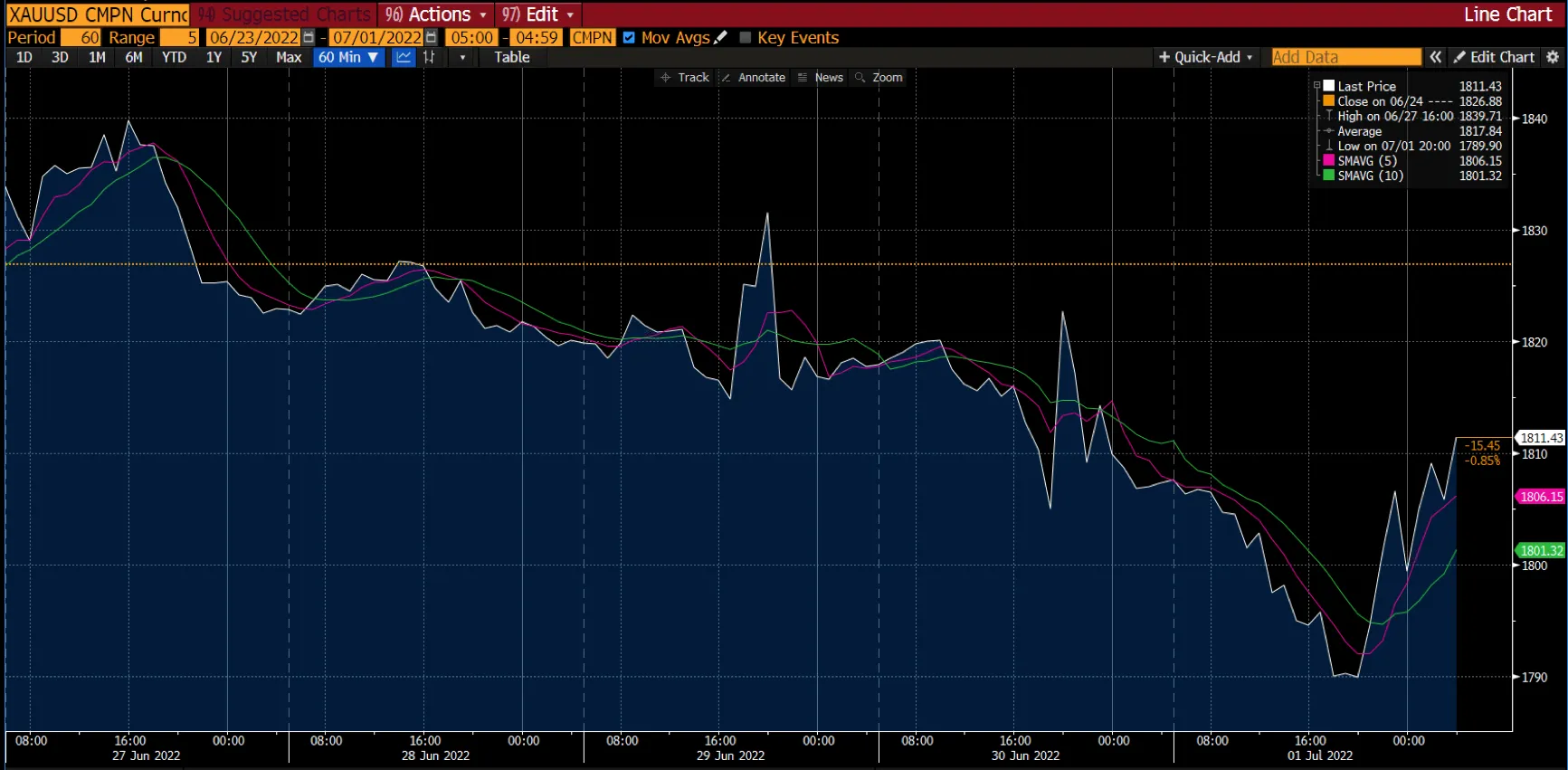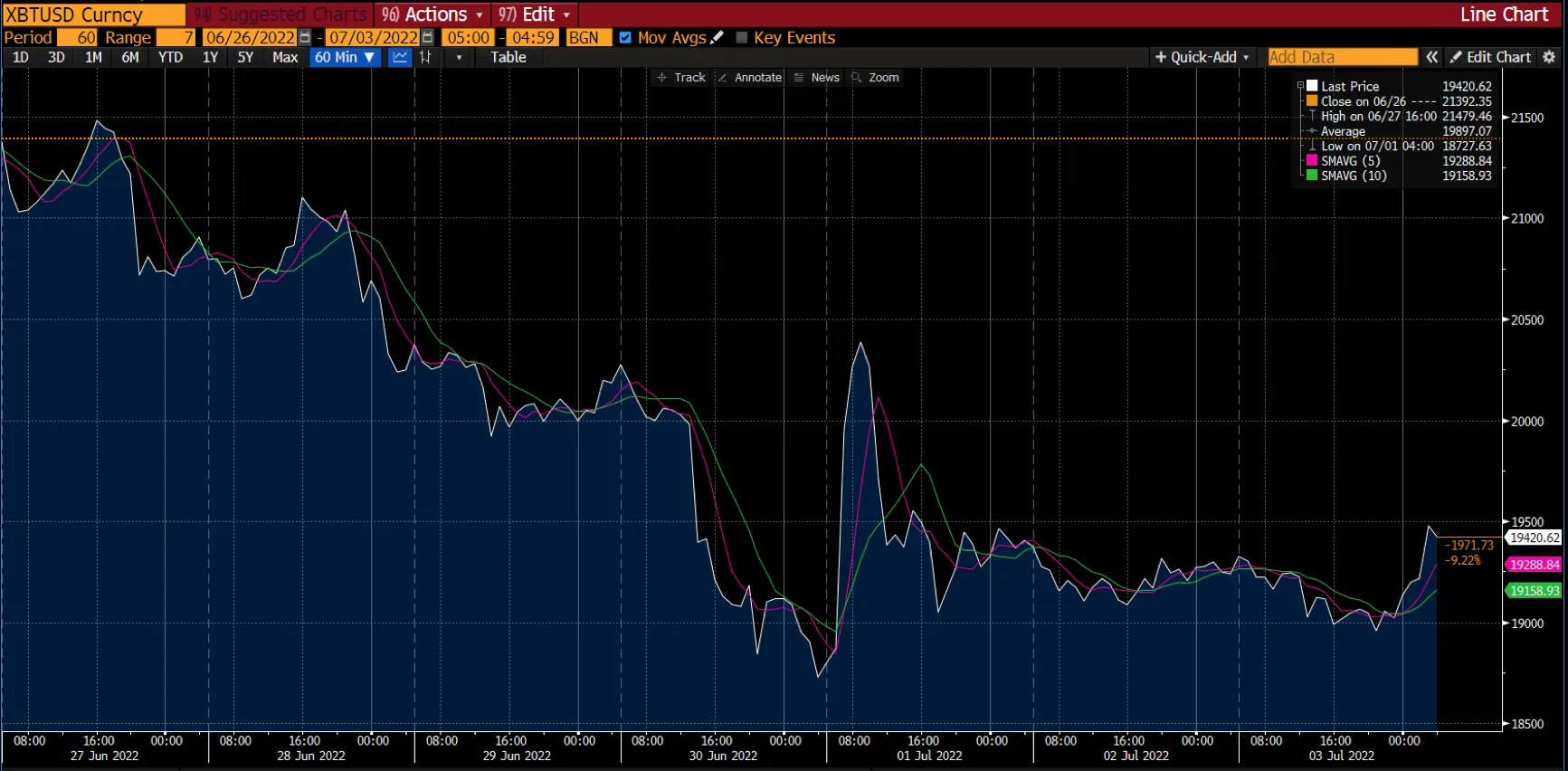Market news – Week 1, July 2022

Half of 2022 has ended, and while inflation remains at the forefront of trader sentiment, last week highlighted that traders also fear the onset of an economic slowdown. There are fears of recession in all 4 markets, with some assets experiencing their worst quarter for the year and others experiencing their worst first two quarters in over 50 years.
Forex

Last week, EUR/USD appreciated briefly before resuming its bearish trend. Despite holding above the $1.06 level in the first half of the week, the leading currency pair plunged as low as $1.0366 – its lowest level since June. Although US dollar bulls rallied throughout the week, recession fears pushed it back. Based on the chart above, the pair ended the week at around $1.0414, establishing a bearish tone with lower lows and lower highs.
Traders were concerned that aggressive rate hikes by the Federal Reserve and European Central Bank would tip the global economy into recession. There was a ray of hope, however, that emerged from China lifting its lockdown, alleviating inflation and growth concerns and temporarily favouring US dollar bears.
Meanwhile, the recent bearish consolidation re-energised GBP sellers, who smashed GBP/USD below $1.20 for the first time in 2 weeks. Last week, the pair lost around 200 pips, effectively ending the previous week's recovery. GBP was under pressure due to Brexit fears and recession fears.
In the coming week, the markets are awaiting the minutes of the June Federal Open Market Committee (FOMC) meeting and the US Nonfarm Payrolls for a new direction.
Level up your trading strategy with the latest market news and trade CFDs on your Deriv X Financial account.
Commodities

Gold started the week at around $1,830 but ended near $1,811. In the last week, spot gold prices dropped by 1.04%.
The US ISM Manufacturing Purchasing Managers' Index (PMI) statistics released on Friday, 1 July 2022, fueled fears of a recession and sent gold prices to their lowest level in five weeks – $1,783.50. In June, the US ISM Manufacturing PMI dropped to 53.0 from 54.9 and 56.1 in May, marking the lowest reading in 2 years.
Powell's semi-annual congressional testimony on Wednesday, 29 June 2022, didn't stimulate the gold market but came off as sufficiently hawkish to drive gold prices down for the week. Furthermore, due to hawkish monetary policies from top central banks, gold, which doesn't pay interest, suffered its worst quarter in more than a year.
As seen in the chart above, gold maintained its bearish tone. However, it bounced back on the last day of the week and held its position above the 5 and 10 SMA at $1,806 and $1,801, respectively.
In addition, oil prices declined for the week as concerns about a worldwide recession weighed on the market at a time when supply remains constrained due to OPEC (Organisation of the Petroleum Exporting Countries) production declines, unrest in Libya, and sanctions against Russia.
Cryptocurrencies

After recovering more than 20% from its lowest prices in 2022, the cryptocurrency industry made a complete U-turn and dropped 12% last week. Bitcoin, the biggest and most popular cryptocurrency, fell below $20,000 while almost all altcoins, starting from Ethereum, bled.
Bitcoin entered the week with a solid $21,073.55 and closed below $20,000. This was the third-worst monthly closing in history with high uncertainty in the global economy and the crypto market.
As seen in the chart above, Bitcoin hit its lowest on Friday, 1 July 2022, when the price reached $18,728. However, since then, it managed to gain traction and maintain a sideways position for the week at around $19,421.
Ethereum, on the other hand, failed in its attempt to recover. It instead followed a stable downward trend with an opening price of $1,203.85, finishing the week at $1,072.16 while struggling to stay in the $1,100 price zone.
In addition, traders' massive sell-off and crypto company Celsius' pausing of withdrawal services appear to have triggered the crypto crash.
Maximise market opportunities by sharpening your trading strategy and trading the financial markets with options and multipliers on DTrader.
US stock markets

*Net change and net change (%) are based on the weekly closing price change from Monday to Friday.
US stock markets finished their worst first half in over 50 years as the economy heads into the second half of 2022. Currently, all 3 indices are in a bear market as they lost their fourth week in a row out of the past 5 weeks. To sum up, the Dow fell by 1.08% for the week. The S&P 500 lost 1.92%, and the Nasdaq finished lower by 3.52%.
The US equity markets declined for the week despite a rally on Friday, 1 July 2022, as concerns over persistently high inflation, expectations for aggressive central bank tightening, and recession risks prevailed.
Furthermore, May's Personal Consumption Expenditures (PCE) data showed that consumers were also cutting back. As a result of inflation, purchases fell by 0.4% in May – the first decline in 2022.
This week, minutes of the FOMC's latest policy meeting, which was held in mid-June, will be available on Wednesday, 6 July 2022. On Friday, 8 July 2022, the June Nonfarm Payrolls report from the Labor Department will be released.
Now that you’re up-to-date on how the financial markets performed last week, you can improve your strategy and trade CFDs on Deriv MT5 Financial and Financial STP accounts.
Disclaimer:
Options trading, Deriv X platform, and STP Financial accounts on the MT5 platform are not available for clients residing in the EU.



